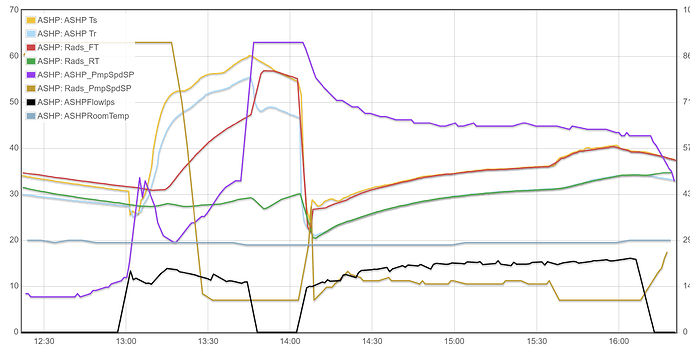Results of ‘sort of’ engineering out my low loss header…
I don’t have enough data to say whether what I’ve done has actually improved performance yet, but I thought I show what can be done with a bit of Arduino hardware and some relatively simple code. My system was installed with a LLH, which I was never very keen on, but the installer was so nervous about not putting one in, I let him do it (though at his expense!). I’ve been working up a solution to ensure that there is no shunting in the LLH and so the heat pump sees exactly what’s happening in the house. The way this is now working is that the radiator/secondary circuit pump speed is being controlled to maintain 5C delta T and the ASHP side/primary pump is controlling to whatever the actual radiator circuit delta-T is. My radiator circuit pump cannot maintain 5C delta-T at all time, as you can see in the chart (towards the end - the Rads_PmpSpdSP goes to 10% PWM, which is the minimum value and corresponds to maximum pump speed. (So perhaps my installer was right to be nervous, or should just have installed a bigger pump). The control system is working very well - the delta-Ts across the inlet and outlet of LLH quickly match, meaning the ASHP control system is seeing pretty much what would happen if there was no LLH, but what I’m not sure is whether 5C is the right setpoint to use, given that I’m controlling it, the AHSP can’t actually control to that as well. (Note that the controller switches to controlling 5C delta T on the primary circuit when its in DHW mode - as per start of chart) Would it be better just to run the secondary pump at full speed and control the primary to match the delta-T or perhaps to se the SP higher - to 7C say, so that the ASHP reduces the heat input or flow temperature? It’s hard to know without knowing what the Auto-adapt control is doing, but would welcome peoples thoughts.
